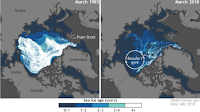Arctic sea ice is highly reflective; the oldest ice boomerangs 80 percent of solar radiation back into space. (Scientists say it has “high albedo.”) As it melts, that reflective shield gives way to exposed ocean surface, which absorbs and traps the sun’s heat. The more ice melts, the more heat the ocean absorbs, melting even more ice. Scientists call this vicious circle an “ice-albedo feedback loop.”
Before humans started messing with the climate, most of the Arctic ice pack withstood consecutive darkness-free summers without melting. Now this “multi-year” ice is almost completely gone: 95 percent of the oldest, most reflective Arctic ice has melted. (You can watch it go in this terrifying video.) “First-year ice” is far thinner, more delicate, and less reflective. It’s also prone to melting entirely in the spring and summer months, which are getting warmer by the year.
If the entire Arctic ice pack should melt, scientists predict that we’d see an “unmitigated disaster.” Without the planet’s Arctic heat shield, the ice-albedo feedback loop would quickly usher in an additional half-degree Celsius of warming worldwide, and with it, widespread global damage. That would lead to more rapid melting of the Arctic permafrost, releasing vast amounts of methane — a greenhouse gas that, for its first 20 years in the air, traps 84 times more heat than carbon dioxide.
It’s a nightmarish thought. But that’s where Dr. Leslie Field’s work comes into the picture.
Field’s “inconvenient hobby,” as she describes it, which has now turned into full-time-plus work for her and the Ice911 team, began with experiments carried out with buckets of water set out on her sunny, Bay Area deck. She tried spreading reflective sheets on Lake Tahoe and on lake ice in the Sierras. Then she began experimenting with tiny, hollow microbeads made mostly of silica, a type of sand made of quartz rock. (Unlike the plastic nanobeads found in cosmetics, which have become a scourge on the world’s waterways, the silica microbeads are safe for animals, aquatic life, and ecosystems.)
When spread across ice, these beads become a reflective shield against the sun, enhancing the ice’s natural albedo. They’re buoyant, so they float on melt ponds and slushier patches of sea ice. Spread these beads across strategic areas of Arctic ice, Field thought, and more of it might survive through the summers, keeping reflectivity high and short-circuiting that vicious ice-albedo feedback loop.
Field and her team have tested the microbeads across more than three football fields’ worth of lake ice at the Barrow Arctic Research Center/Environmental Observatory since 2016. Buoys designed and placed by the Ice911 team since 2010 send data wirelessly from various test sites back to the organization’s labs in Sunnyvale and Redwood City, California, so that researchers can measure ice growth, reflectivity, weather, and water currents. They use satellite imagery and aerial photos taken by Maverick, their line-of-sight drone, to compare the reflectivity of treated ice to untreated ice.
Their findings so far: Ice treated with silica microbeads grows thicker and more reflective with each application. Ice911 modeling suggests that spreading the beads in only a few strategic areas, like the Beaufort Gyre or the Fram Strait, could reverse melting across the Arctic.
“By using just a tiny amount of material, you end up making young ice seem more like multiyear ice, and that changes the radiative balance in the Arctic back to where it was,” Field said. “You think, those are pretty humble goals — is it going to be enough? As it turns out, it’s enough. This material makes a very large impact on regrowing ice and preventing further temperature rise in the Arctic.”
Field connected with the Foundation for Climate Restoration, which became a supporter of Ice911’s work. Founding Executive Director Ilan Mandel says: “Rebuilding Arctic ice became one of the three pillars of Climate Restoration, along with removing a trillion tons of CO2 from the atmosphere and transitioning to renewable energy. And slowing the Arctic’s contribution to global warming could buy time for other actions to restore our climate.”
Ice911 is currently raising money to fund more of its work, and Field predicts she’ll have the permits necessary to start testing her solution on sea ice within one to three years. Ultimately, she hopes to hand over her technology to organizations like the United Nations or a consortium of Arctic-facing nations.
Read more at In the Warming Arctic, a Promising Solution to Climate Change

No comments:
Post a Comment